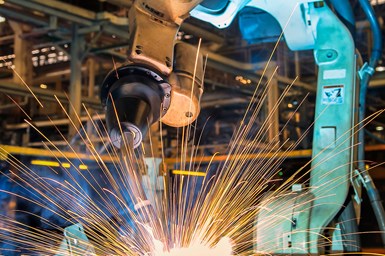ESPRIT CAM, Alma CAM Partner for Robot Additive DED Programming
Collaboration to provide customers with an end-to-end solution for robot programming, simulation, verification, collision detection, code generation and more.

ESPRIT CAM and Alma CAM Partner for robot additive DED programming.
ESPRIT CAM software for CNC programming, optimization and simulation is partnering with Alma, a leading CAD/CAM provider for robotics, to create a complete programming solution for robot additive direct energy deposition (DED).
Additive DED is a series of metal 3D printing technologies that creates parts by melting and fusing material as it is deposited. Wire arc additive manufacturing (WAAM), also known as DED-arc, is one of the additive DED technologies being applied in robot additive DED to produce the near net-shape preforms with significant cost and lead time reductions, increased material efficiency and improved component performance.
In order to program a robot to perform an additive DED task, an engineer needs to determine not only the toolpath of the DED head but also the robot arm movements to efficiently achieve the ideal toolpath. To provide customers with an end-to-end solution for programming robot additive DED, ESPRIT has been working with Alma to bring together advanced toolpath planning in both subtractive and additive areas with leading technology in robotics trajectory computation and offline programming of arc welding robots.
This collaboration enables Alma to use the full ESPRIT additive DED cycles such as 3X, 4X and 5X, while also enabling ESPRIT to support industrial robot brands, including Yaskawa, ABB, Fanuc, Kuka and others.
The result of this technology partnership is a complete workflow to provide end-users with dedicated additive toolpath planning and programming. It also includes robot programming, simulation, verification, collision detection and code generation, as well as subtractive finishing process planning, simulation, verification, collision detection and G-code generation.
Related Content
-
Semiconductors, Tungsten, AM Affordability and More from Formnext 2024: AM Radio #56
The trade show included increased applications for the semiconductor market, machine launches and technology advances aimed at cost cutting, plenty of LFAM and more. Listen to our conversation on Formnext 2024.
-
Decentralized Manufacturing Network Aims to Make 3D Printers a Shared Global Resource
The 3DOS additive manufacturing network will let OEMs and creators take advantage of open 3D printer capacity anywhere in the world.
-
The Top 10 Additive Manufacturing Stories of 2024
Defense, space exploration, thermal management — these are some of the topics that captured the Additive Manufacturing audience’s interest in 2024. But there’s also an overarching theme: Don't wait for additive manufacturing to be perfect. Instead, leverage the applications perfect for AM.













